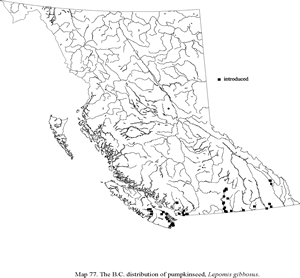Dorsal spines (total): 10 - 12; Dorsal soft rays (total): 10 - 12; Anal spines: 3; Anal soft rays: 8 - 11; Vertebrae: 28 - 30 Biology:
Pumpkinseed
Family: Centrarchidae
Introduction
|
Species Information
Biology
|
Distribution
|
BC Distribution and Notes This eastern North American fish is an attractive little pest. It competes with native species and has extirpated some scientifically valuable stickleback populations on Vancouver Island. It is still spreading on Vancouver Island and the B.C. mainland. Apparently, people keep small pumpkinseeds as aquarium fish but release them when they get too big or become a nuisance. Thus, in B.C., humans almost always spread this species. Source: Information provided by Don McPhail for E-Fauna BC. Global Distribution North America: New Brunswick in Canada to South Carolina in the USA. Widely introduced. Several countries report adverse ecological impact after introduction. Source: FishBase. Page, L.M. and B.M. Burr 1991 A field guide to freshwater fishes of North America north of Mexico. Houghton Mifflin Company, Boston. 432 p. |
Status Information
|
BC Ministry of Environment: BC Species and Ecosystems Explorer--the authoritative source for conservation information in British Columbia. |
Taxonomic and Nomenclatural Links
Additional Range and Status Information Links
Additional Photo Sources
Species References
|
Carl, G. Cliford and C. J. Guiguet. 1958. Alien Animals in British Columbia. British Columbia Provincial Museum, Department of Education, Handbook No. 14. Victoria. Available Online. McPhail, J. D. 2007. The Freshwater Fishes of British Columbia. The University of Alberta Press, Edmonton.
Scott, W. B. and E. J. Crossman. 1973. Freshwater Fishes of Canada. Bulletin 184. Fisheries Research Board of Canada, Ottawa. |
